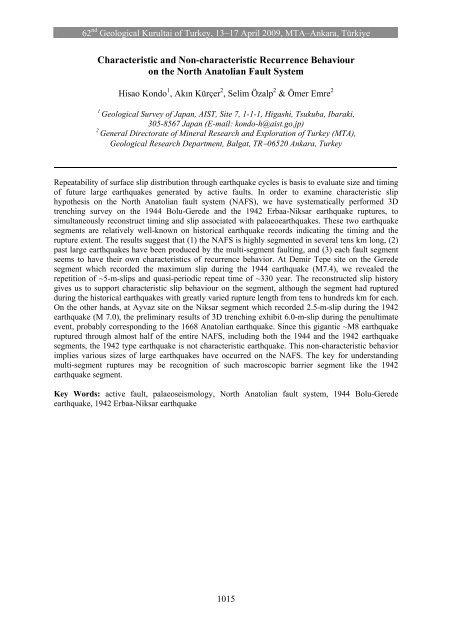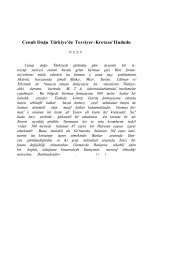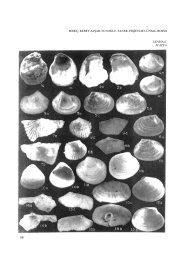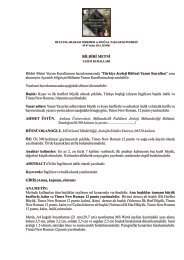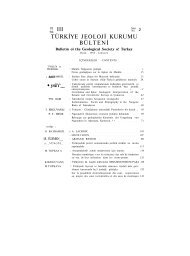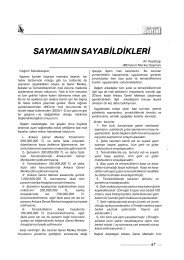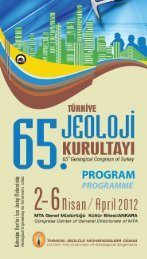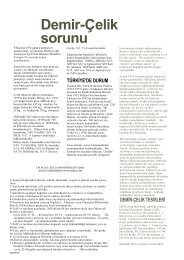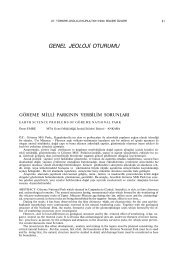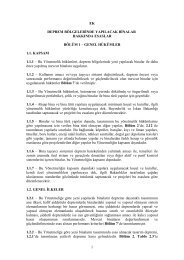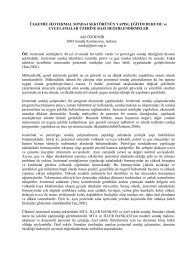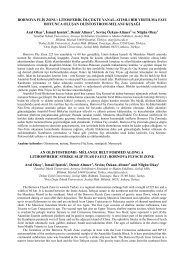Paleosismoloji ve Arkeosismoloji Palaeoseismology and ...
Paleosismoloji ve Arkeosismoloji Palaeoseismology and ...
Paleosismoloji ve Arkeosismoloji Palaeoseismology and ...
Create successful ePaper yourself
Turn your PDF publications into a flip-book with our unique Google optimized e-Paper software.
62 nd Geological Kurultai of Turkey, 13−17 April 2009, MTA–Ankara, Türkiye<br />
Characteristic <strong>and</strong> Non-characteristic Recurrence Behaviour<br />
on the North Anatolian Fault System<br />
Hisao Kondo 1 , Akın Kürçer 2 , Selim Özalp 2 & Ömer Emre 2<br />
1<br />
Geological Sur<strong>ve</strong>y of Japan, AIST, Site 7, 1-1-1, Higashi, Tsukuba, Ibaraki,<br />
305-8567 Japan (E-mail: kondo-h@aist.go.jp)<br />
2<br />
General Directorate of Mineral Research <strong>and</strong> Exploration of Turkey (MTA),<br />
Geological Research Department, Balgat, TR−06520 Ankara, Turkey<br />
Repeatability of surface slip distribution through earthquake cycles is basis to evaluate size <strong>and</strong> timing<br />
of future large earthquakes generated by acti<strong>ve</strong> faults. In order to examine characteristic slip<br />
hypothesis on the North Anatolian fault system (NAFS), we ha<strong>ve</strong> systematically performed 3D<br />
trenching sur<strong>ve</strong>y on the 1944 Bolu-Gerede <strong>and</strong> the 1942 Erbaa-Niksar earthquake ruptures, to<br />
simultaneously reconstruct timing <strong>and</strong> slip associated with palaeoearthquakes. These two earthquake<br />
segments are relati<strong>ve</strong>ly well-known on historical earthquake records indicating the timing <strong>and</strong> the<br />
rupture extent. The results suggest that (1) the NAFS is highly segmented in se<strong>ve</strong>ral tens km long, (2)<br />
past large earthquakes ha<strong>ve</strong> been produced by the multi-segment faulting, <strong>and</strong> (3) each fault segment<br />
seems to ha<strong>ve</strong> their own characteristics of recurrence behavior. At Demir Tepe site on the Gerede<br />
segment which recorded the maximum slip during the 1944 earthquake (M7.4), we re<strong>ve</strong>aled the<br />
repetition of ~5-m-slips <strong>and</strong> quasi-periodic repeat time of ~330 year. The reconstructed slip history<br />
gi<strong>ve</strong>s us to support characteristic slip behaviour on the segment, although the segment had ruptured<br />
during the historical earthquakes with greatly varied rupture length from tens to hundreds km for each.<br />
On the other h<strong>and</strong>s, at Ayvaz site on the Niksar segment which recorded 2.5-m-slip during the 1942<br />
earthquake (M 7.0), the preliminary results of 3D trenching exhibit 6.0-m-slip during the penultimate<br />
e<strong>ve</strong>nt, probably corresponding to the 1668 Anatolian earthquake. Since this gigantic ~M8 earthquake<br />
ruptured through almost half of the entire NAFS, including both the 1944 <strong>and</strong> the 1942 earthquake<br />
segments, the 1942 type earthquake is not characteristic earthquake. This non-characteristic behavior<br />
implies various sizes of large earthquakes ha<strong>ve</strong> occurred on the NAFS. The key for underst<strong>and</strong>ing<br />
multi-segment ruptures may be recognition of such macroscopic barrier segment like the 1942<br />
earthquake segment.<br />
Key Words: acti<strong>ve</strong> fault, palaeoseismology, North Anatolian fault system, 1944 Bolu-Gerede<br />
earthquake, 1942 Erbaa-Niksar earthquake<br />
1015


